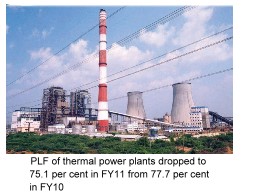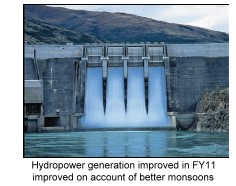
Total power generation
including that from Bhutan
joint venture increased by 7.6
per cent to 75.5 billion kwh (Gwh)
during March 2011, against 6.8 per
cent in February and 9.3 per cent in
January. Total generation during FY11
was placed at 811 billion kwh, 5.5 per
cent higher than in FY10.
Power generation had increased by
6.8 per cent in 2009-10, 2.5 per cent in
2008-09 and 6.3 per cent in 2007-08.
Thermal power, which constitutes over
three-fourths of electricity generation,
was up 3.8 per cent. Four-fifths of
generation was based on coal as fuel, 14
per cent on gas, around 4 cent on lignite,
and 2 per cent on liquid fuel, etc.
Thermal power stations lost around 14
billion kwh due to coal shortage and
poor fuel quality. Loss of generation
due to backing down of stations due to
low schedule from beneficiary states
was reported as 7 billion kwh by the
generating utilities, according to data
released by Central Electricity
Authority. Capacity utilization in
thermal power plants, as measured by
plant load factor, dropped from 77.7 per
cent to 75.1 per cent in FY11.
At 26.3 billion kwh, generation from
nuclear power stations was more than
the target for the year and registered a
growth rate of 41 per cent over the last
year. The average PLF of nuclear plants
increased from 51.1 per cent to 65.5 per
cent. Much of this improvement came
about due to higher availability of
uranium during the year.

Generation from hydropower
stations improved considerably on
account of good monsoon. Energy
generation was 114 billion kwh,
registering a growth of 10 per cent
over the year. Barring the southern
region that recorded only 1.7 per cent
increase, all other regions experienced
good growth in generation. The Indo-
Bhutan JV Tala hydropower project
supplied 5.6 billion kwh, up 4.7 per
cent from FY10.
POWER DEFICIT
The average deficit worked out
provisionally to 7.5 per cent in March,
easing from 7.8 per cent in February,
8.2 per cent in December and double
digits in the first five months of FY11.
Average deficit over the financial year
worked out to 8.5 per cent—the
situation improving from a 11.7 per
cent deficit in FY10 and 10.9 per cent
in FY09. In fact, after running higher
till August, relative to year ago levels,
power deficit has tended to be less
severe than year-ago levels in the
subsequent seven months.
Cumulative peak demand level deficit
worked out to 10.3 per cent, against
13.3 per cent in earlier year.
POWER GENERATION: 2010-11 |
|
Generation (Gwh) |
Achievement (%) |
y-o-y |
|
Planned |
Actual |
|
% chg |
| Thermal |
690.857 |
664.914 |
96.2 |
3.8 |
| Nuclear |
22.000 |
26.285 |
119.5 |
41.0 |
| Hydro |
111.352 |
114.296 |
102.6 |
10.0 |
| Bhutan Import |
6.548 |
5.610 |
85.7 |
4.7 |
| Total |
830.757 |
811.104 |
97.6 |
5.6 |
| Source for basic data: CEA |
Among the regions, the western
region, which accounts for one-third
of the power country needs, faced 14.7
per cent deficit over the year, much
higher than the average for the
country. Northern region faced 8.9 per
cent deficit and eastern region 9.9 per
cent. Southern region faced much
lower deficit of around 6.3 per cent.
Among the states, Maharashtra, the
biggest power consumer state, faced 18
per cent power deficit in FY11. Andhra
Pradesh faced 5.1 per cent deficit while
the corresponding metrics for Gujarat
and Karnataka were 7.8 per cent and
8.3 per cent, respectively.